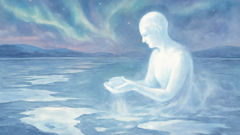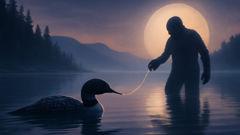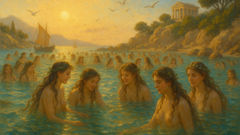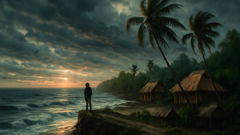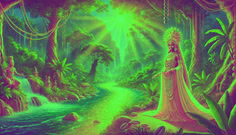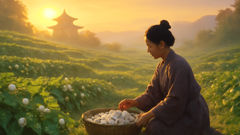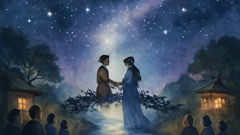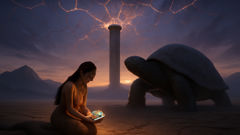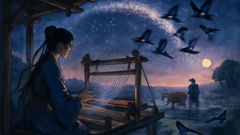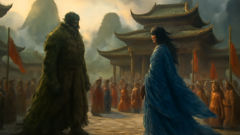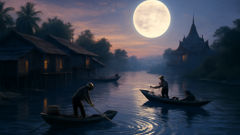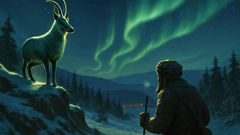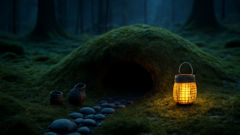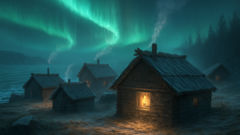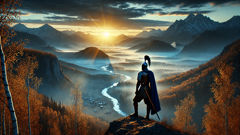Introduction
In the long silence before names and maps, before trees reached for a sun that had not yet decided to watch, there was only the pale pulse of the primeval ocean. It lay like a single slow breath under a sky that was not yet sky, a horizon that did not yet hold distance. From that wide water rose a presence that the elders of the Sakha speak of with the careful breath of people who keep fire in winter: a Great White Creator, a being of light and stillness whose whiteness was not merely a color but a manner of being, luminous as frost, patient as glacier. The sea listened. The Creator watched. And in that listening, the first stirrings of life shaped themselves. This is a story braided of salt and snow, of canoe and hoof, told by hearthlight to children who learn how to honor wind and animal, how to speak to stone, and how to meet the world with a gratitude that keeps it turning. It is a story of origin where the land itself is a careful work of hands and breath; where ice and river, birch and larch, reindeer and raven, all owe memory to a time when a single thought gathered strength and divided water into sky and earth. Retold here with respect and wonder, the tale moves between the hush of tundra nights and the crack of thawing rivers. It remembers a covenant: that humans belong by kinship to the creatures and the weather, that creation is an exchange—song for shelter, story for meaning—that the Sakha have carried across generations.
Birth of Names and the Shaping of Land
The first thing the Great White Creator did was to listen. It is said that the Creator had no hurry, for hurry is a human fever; instead a patient calm like old snow filled the being. The primeval ocean answered every silence with a ripple, and on the third listening the Creator put its hands beneath the water and lifted. Water clung to its fingers like glass, spun into filaments of mist that froze to make the first islands. Slow and deliberate, the Creator separated the sea so that rock could breathe. Where the Creator pressed, the sea became shore; where the Creator breathed, rivers remembered how to run. The young land was not yet named. Names are a way humans keep the world from forgetting itself, and so the Creator walked along the rims of new shores and called out: this is stone, this is peat, this is river. Those names stuck like lichens.
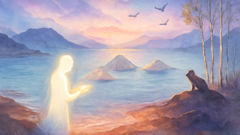
Around these newborn coasts came creatures, not by accident but because the Creator invited them—first the water-birds, then the fish with their glittering scales that were fragments of the ocean's own memory. A white fox, whose coat carried the echo of the Creator's light, stepped from a floe and balanced on the world as if testing a song. The Creator taught the fox cunning quietness and the meaning of winter hunger. The raven, black as a hole in the sky, arrived with a laugh that stacked shadow into patterns; the Creator gave the raven speech and the cleverness to steal the sun for those who could not yet hold fire. Each gift given shaped the manners of beings that would inhabit the cold.
But land without people was a poem without a reader. So the Creator took a handful of river silt, warmed it with its breath, and shaped figures. These shapes were not yet people but possibilities—small and pliant as clay. Into them the Creator poured song, for the Sakha know that names and songs are the threads of living. With each verse the clay warmed and straightened; with each story the eyes opened. Yet the Creator was careful: to make people into stewards rather than tyrants, to balance hunger with reverence. The first humans were given the ways of the land—how to welcome a guest animal with smoke and meat, how to bind a wound with moss and bark, how to read the sky for storms. They were taught also how to listen. For the Creator's first lesson was simple: everything that gives life asks for a name and for respect.
Seasons were the Creator's clock. Storms flung their fury over newborn plains so that the people learned to build shelters and to speak to the winds. Winters, silver and absolute, taught patient endurance; summers, short and bright, taught abundance and haste. Rivers grew teeth of ice and then revealed their pearls when thaw came, reminding people that hardship and plenty were braided and that gratitude must be braided too. From the Creator's hands the land spread—low marsh to high ridge, birch groves that gossip in wind to the dark sprawl of taiga. Each place gathered a story, and each story taught the humans a name or a rule: do not take more than you need, thank the beast whose life you use, remember the dead in your songs.
As humans learned to move and to mark time, they made small shrines. Stones were piled, smoke rose to the low stars, and offerings of fish and birch sap were left at river mouths. Elders told how the Creator would sometimes walk among them, disguised as a white hare or as a pale traveler, checking if the covenants were kept. Those who broke the unwritten rules found the ground colder beneath them; those who kept them found the land generous. So the moral of care and reciprocity sank deep.
But creation was not complete with the making of people. The Creator still had more to coax from the sea. It gathered the reeds and braided them into reeds of hills and into the ribs of boats; it put in people's mouths a song that named seasons. It taught hunters to follow winter trails by moonlight and told the women a lullaby that would enter the bones of children. The Creator made space for myth itself: a place where supernatural forces and human lives intersected, where spirits of the lake and of the birch could be bargained with, where shamanic journeys would later cross thresholds of frost and flame. In the beginning, the world was being given a habit of meaning. The people learned that they belonged not above nature but within it, and that to live was to be in conversation: with animals, with weather, with the restless souls of ancestors.
Rivers remembered the names the Creator had called. Rocks kept stories in their grain. The sky, when it finally took its place, cradled the aurora like a geologic memory of the Creator's first light. Children of the Sakha grew to know the land as a living library, each valley a chapter, each migration a poem. They learned to tell the tale of how the Great White Creator coaxed the earth from water not as a single heroic act, but as a long weaving of gift into response. The world, in this telling, was a contract written in breath and frost: the Creator offers a place to live, and people must repay with careful hands and thoughtful names. And that is how the land was shaped, one listening, one name, one gift at a time.
The People and the Covenant of Reciprocity
Creation, the elders would say, took time because it needed time to teach reciprocity. The Creator did not merely hand down laws carved in stone; instead it showed human beings how to move through a fragile world where every action bent the future. In the earliest seasons the people were few, their faces still marked by the Creator's shaping. They learned to wear fur not as ornament but as memory, each stitch a prayer to the beasts whose skins warmed them. Around communal fires they learned songs that would later become the protocols of hunting and the grammar of gratitude. When a reindeer was taken, youth learned to thank with words and to leave gifts for the spirit of the animal. When fish were plucked from rivers, some were returned to shallow water as first offerings. Such small acts were the scaffolding of culture: habits that kept the land generous.
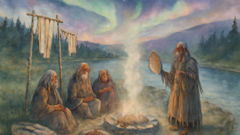
Shamans rose in those first generations—intuitive intermediaries whose work was to read the weather and translate the designs of animal movement into human strategy. They carried birch-bark drums that sounded like heartbeats and wore headdresses that recalled the Creator's own white luminescence. When the reindeer migration faltered, shamans listened at rivers and traced the illness of waters by watching insect hatches and ice melt; they performed rites, not to assert control, but to restore a balance the people had frayed. The Creator, stories insist, approved of these humble repairs because they recognized the world as an interdependent weave. No single species existed for itself, and no one being could dominate without breaking the pattern.
Conflict came too, as it does everywhere. Some sought to hoard the land's gifts, building prideful caches that upset the local ecology. Others failed to keep the covenants: leaving offerings untended, taking more than need, refusing to sing the names of the dead. In those cases the great White presence was more severe. Storms answered, colder and longer; fish retreated to deep channels; herds thinned. The elders taught that punishment was not vindictive but corrective, like a frost that prunes a tree so new growth may come. To mend such harm, communities organized public acts of restitution: offerings placed at river mouths, songs carried into the night, the re-weaving of nets and the mending of broken tools. These acts were ceremonies of apology and repair, acknowledgements that humans were not owners but relatives.
The Creator also introduced boundaries—ritual prescriptions that protected certain kinds of land and certain bushes of berry. Some lakes were declared sacred, not so people would worship water more than necessity, but so that water and fish would be allowed rest and renewal. Meadows where pregnant does grazed might be given temporary sanctuary; patches of lichen might be left unharvested because small things, elder storytellers said, carry future abundance. These constraints seemed small until decades turned to centuries and the patterns they produced sustained entire ecosystems. Why keep those rules? The answer was taught in lullabies: the land remembers gratitude, and gratitude becomes habit.
As the human population grew, villages formed near dependable springs and river bends. They were not locked settlements but nodes in a living map; families traveled with seasons, following reindeer and fish runs, visiting relatives across long snow plains. Hospitality was crucial—every guest was tested with smoke and stew and song; refusal of hospitality marked a person as outcast. As time went on, specialized crafts developed: some learned to tan hides into supple boots; others wove nets with patterns that told family stories; still others carved wooden idols and painted them with the simple geometry of ripples and frost. These crafts were not mere labor; they were ways of remembering the Creator's first shaping. A carved bowl might be incised with the name of a river; a drum might be decorated with the sign of a star that led ancestors to a safe crossing. In the making, people had a way of speaking back to the world.
The stories also tell of teaching: how elders would summon children to the edge of the lake and ask them to listen. On windless nights they would say: the lake speaks in the small sounds between waves; learn to hear it and you may know when winter will come early. And the children listened, discovering that the sound of ripples was different when a storm brewed far away. That attentiveness became the bedrock of survival. To live well was to watch and to wait, to understand the slow signs of seasons and to act in a measured way. The Creator's whisper thus became not a command but a teacher's patient voice. In time the people built a relationship to the world that was named in the Covenant of Reciprocity: take with thanks, give back with care, sing the names of those who walked the land before you.
Legends hold that the Great White Creator still walks at the edges of human sight. Hunters on clear nights have seen a pale traveler at a ridge or a white hare that avoids snares. Shamans sometimes recount dreams in which the Creator laid a marble-skinned hand on a forehead and transferred a memory of rivers—how they once flowed and how they might be coaxed to flow again. These visions are reminders: that origin is ongoing, that the making of the world is also the making of obligation. The Sakha did not take the land as a resource to be exhausted but as kin to be sustained. That ethic, born in the time when ocean yielded to stone, has endured as a cultural backbone. In the telling of this part of the myth, people are not footnotes in creation; they are conversationalists in a long, collaborative act. The Creator offered a beginning and a model for behavior, and the people learned to answer, time and again, with music, ritual, and repair.
Conclusion
To end a creation story is also to remember that endings are beginnings disguised as rest. The Sakha preserve this myth not as a fossilized origin but as a living habit: a set of manners the people practice each day. The Great White Creator, who coaxed land from ocean and taught the first names, remains in memory as promise and as instruction. The world that rose from the primeval sea carries with it the imprint of that first care—landscapes that demand respect, seasons that reward patience, animals that ask for human gratitude. The covenant the Creator established is not written in a single decree but in countless small acts: leaving a fish at a river mouth, speaking the name of a place, mending what was broken, telling a child why the birch is called the wind's cousin. In modern times the story adapts: villages shift, tools change, distant lights arrive, but the core lesson persists. People who learn the tale of the Great White Creator learn to listen across generations, to weigh consumption against renewal, and to practice reciprocity as both spiritual and pragmatic economy. That is why elders still tell the tale and why youngsters still trace the lines of the story with fingers in the frost. The primeval ocean may now be browsed by maps and borders, but in song and story the Sakha keep the memory that land and life were a mutual gift. And in keeping this memory alive, they perpetuate a covenant that protects not only culture but the land itself. The myth gives origin, and origin gives responsibility—one must tend what was given, for to neglect that tending is to forget the hands that shaped the world.

